
Our Top Picks


The best sales workflow automation software helps you orchestrate every part of your sales process without constant manual intervention.
In the past decade, workflow automation for sales has evolved beyond simple task automation. Modern platforms now combine AI, CRM logic, and multi-app integrations to handle everything from lead routing to deal approvals with minimal human effort.
In other words, this kind of transformation means sales teams no longer waste hours on administrative tasks or repetitive follow-ups. Instead, they can focus on building relationships, closing deals, and driving strategic outcomes.
After personally testing and reviewing dozens of workflow automation tools for sales teams, I’ve narrowed down the most effective and scalable options. Each software was evaluated for its ease of use, flexibility, CRM compatibility, and ability to handle complex, multi-step sales automation workflows.
1. monday.com

Best for Standardizing Processes
14-day free trial + free plan available
From $8/user/month (billed annually)
Rating: 4.6/5
monday.com has become one of the most widely adopted workflow automation platforms because of its ability to standardize how teams work across departments. While it isn’t limited to sales, its structured environment makes it an exceptional option for teams that need consistent, repeatable sales automation workflows.
The visual nature of monday.com allows users to create an automation logic that connects CRM actions, communication updates, and internal alerts with minimal setup. For sales teams handling large pipelines or complex deal flows, that visual transparency makes it easier to track progress, spot bottlenecks, and maintain accountability.
Why I Picked monday.com
When reviewing tools designed for workflow automation for sales, monday.com stood out for its simplicity and flexibility. Its workflow builder, known as monday workflows, makes it possible to build end-to-end automations using blocks that represent triggers, conditions, and actions.
This makes it perfect for automating the repetitive parts of sales management,such as updating deal stages, assigning new leads, scheduling follow-ups, and sending internal notifications. For example, when a new lead form submission appears in your connected CRM, monday.com can automatically assign it to the right rep, notify the team in Slack, and update the deal status.
The AI-powered workflow generator deserves special mention. You can describe your sales workflow in plain language,such as “Track and follow up with inbound demo requests”,and monday.com will design the workflow automatically. That simplicity helps both managers and non-technical sales reps become more self-sufficient in managing automation.
monday.com Standout Features & Integrations
monday.com brings structure to the chaotic nature of manual sales coordination. It ensures everyone follows the same process while the system quietly handles repetitive work behind the scenes.
Standout features include:
- Time-Based Automations: Perfect for automating follow-ups or reminders at specific intervals after key events, such as a proposal sent or a lead inactive for 3 days.
- Dependency-Based Workflows: Tasks or deals automatically update when their related items change. For instance, when one deal closes, follow-up tasks for onboarding can trigger instantly.
- Formula Columns: These help automate calculations inside boards, such as projected deal value or commission estimates.
- Automation Library: A vast catalog of pre-built templates for tasks like pipeline management, project tracking, and quote approvals.
Integrations:
monday.com connects with popular business tools like Slack, Google Drive, Gmail, Typeform, Trello, Twilio, Jira, GitHub, Dropbox, and Google Calendar. Through Zapier, users can integrate with thousands of additional applications for more custom crm workflow automation for sales teams.
Pros and Cons
Pros:
- Easy-to-create notification and approval flows
- Vast integration ecosystem
- Highly customizable workflows for both small and large teams
Cons:
- Complex workflows may require premium tiers
- Smaller teams may find its full suite overwhelming
Why monday.com Works Well for Sales Teams
Sales teams often struggle to maintain standardized processes as pipelines grow. monday.com’s automation system ensures everyone follows the same steps,from qualification to closing,while reducing admin time. Its visual dashboard gives instant visibility into performance metrics, and automations ensure nothing gets missed.
For teams seeking reliability and structure without coding, monday.com is one of the best workflow automation tools for sales teams looking to bring order and speed to their daily operations.
2. Wrike

Best for Scaling Organizations
Free plan available
From $10/user/month (billed annually)
Rating: 4.2/5
Wrike has long been trusted by growing organizations that need more control over complex processes. Its automation engine brings intelligence and adaptability to sales workflow automation, helping larger teams coordinate tasks, approvals, and communication as workloads expand.
Wrike’s approach to automation feels more analytical than visual. It’s built to manage rules and logic that can scale across departments, which makes it ideal for businesses handling multiple sales regions, verticals, or product lines simultaneously.
Why I Picked Wrike
In any fast-growing sales organization, manual coordination quickly becomes a bottleneck. Wrike’s automation engine eliminates that inefficiency through “if-this-then-that” logic that triggers specific actions whenever a rule is met. For example, when a new lead is created in the CRM, Wrike can automatically assign it to the appropriate account manager, attach supporting documentation, and send an alert to the pipeline owner.
Wrike also includes AI-driven recommendations that identify patterns of delay or workflow breakdown. This capability helps sales managers discover where bottlenecks occur,perhaps certain approvals are slowing deal closure,and propose new automations to improve efficiency.
As an organization scales, Wrike’s structured environment ensures that all workflows remain consistent, even when the team doubles or triples in size.
Wrike Standout Features & Integrations
Standout features include:
- Dynamic Task Prioritization: Automatically adjusts priorities based on deadlines and dependencies to ensure high-value deals get attention first.
- Cross-Tagging: Allows one task to appear across multiple projects, giving visibility to both marketing and sales teams when workflows overlap.
- Proofing Module: Streamlines approvals for sales materials, proposals, or collateral directly within the platform.
- AI Recommendation Engine: Suggests automation rules that optimize workflow efficiency based on activity patterns.
Integrations:
Wrike connects with more than 400 business tools, including CRMs, email platforms, and file storage systems. Popular integrations include Salesforce, Microsoft Teams, Slack, Gmail, and Tableau. A custom API supports advanced setups, which is critical for teams with proprietary CRM environments.
Pros and Cons
Pros:
- Strong automation for approval and task workflows
- Customizable rules and triggers for complex sales structures
- Comprehensive feature set for cross-functional operations
Cons:
- Notifications can become excessive if not tuned properly
- Steeper learning curve than some visual-first tools
Why Wrike Is Ideal for Growing Sales Teams
For organizations managing expanding pipelines, Wrike keeps complexity under control. Its intelligent rules automate repetitive processes,such as lead routing, approval chains, and report generation,while maintaining complete oversight.
Wrike stands among the best workflow automation tools for sales teams because it provides the flexibility needed for growth without sacrificing governance or accuracy. It’s particularly effective in businesses where multiple layers of management must stay informed without micromanaging daily activity.
3. Adobe Workfront
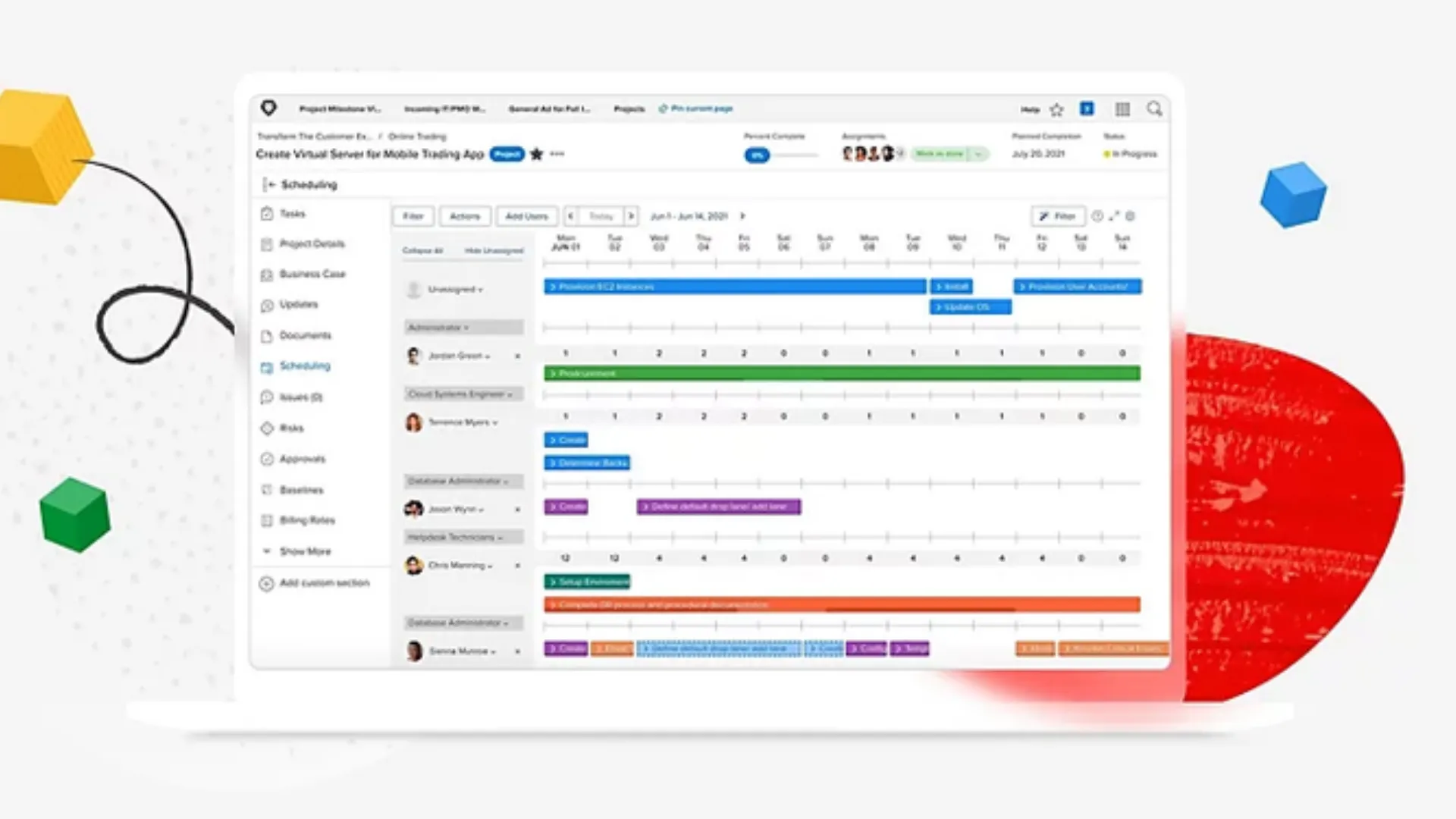
Best for Comprehensive Project Oversight
Free trial available
Pricing upon request
Rating: 4.1/5
Adobe Workfront offers enterprise-grade automation capabilities for organizations that need a single source of truth for projects, approvals, and content workflows. For sales teams operating in large enterprises, it ensures accountability, visibility, and structure across entire deal lifecycles.
While many automation platforms focus purely on task logic, Workfront integrates content, resource allocation, and performance analytics into its workflow automation for sales processes.
Why I Picked Adobe Workfront
Enterprise sales operations typically involve multiple departments: marketing, legal, product, and finance. Adobe Workfront shines in connecting all these stakeholders under one unified workflow.
When a proposal is created, for example, Workfront automatically routes it for review to the legal and finance departments, tracks progress, and provides a single dashboard view of all pending approvals. It ensures no manual handoffs or lost updates.
Additionally, Workfront provides built-in compliance and audit trails,critical for industries that handle regulated or confidential data. Its automation system can generate approval logs and keep every decision timestamped for future reference.
Adobe Workfront Standout Features & Integrations
Standout features include:
- Scenario Planning: Model and compare project or deal execution strategies to identify the most efficient approach.
- Unified Approvals System: Consolidates all document and process approvals in one centralized space.
- Audit-Ready Reporting: Provides visibility into every workflow change, supporting regulatory and enterprise compliance.
- Role-Based Automation: Automatically assigns or escalates approvals based on team hierarchies and permissions.
Integrations:
Adobe Workfront integrates natively with Adobe Creative Cloud, Frame.io, Box, Google Workspace, Jira, Microsoft Teams, Salesforce, and Dropbox. These integrations make it suitable for content-heavy sales teams or organizations that rely on digital asset workflows.
Pros and Cons
Pros:
- Advanced reporting and visibility tools
- Built-in proofing for documents and visuals
- Seamless integration with BI and creative software
Cons:
- Complex initial setup for smaller teams
- Limited offline functionality
Why Adobe Workfront Is Powerful for Enterprise Sales Teams
For enterprises, sales doesn’t end at closing a deal,it extends to delivery, compliance, and client retention. Workfront connects all these moving parts with automation that spans departments.
Its strength lies in oversight: ensuring every deliverable, approval, and document moves automatically through the right hands. This makes Workfront a prime choice for enterprises seeking both governance and automation in their crm workflow automation for sales teams.
4. Qntrl
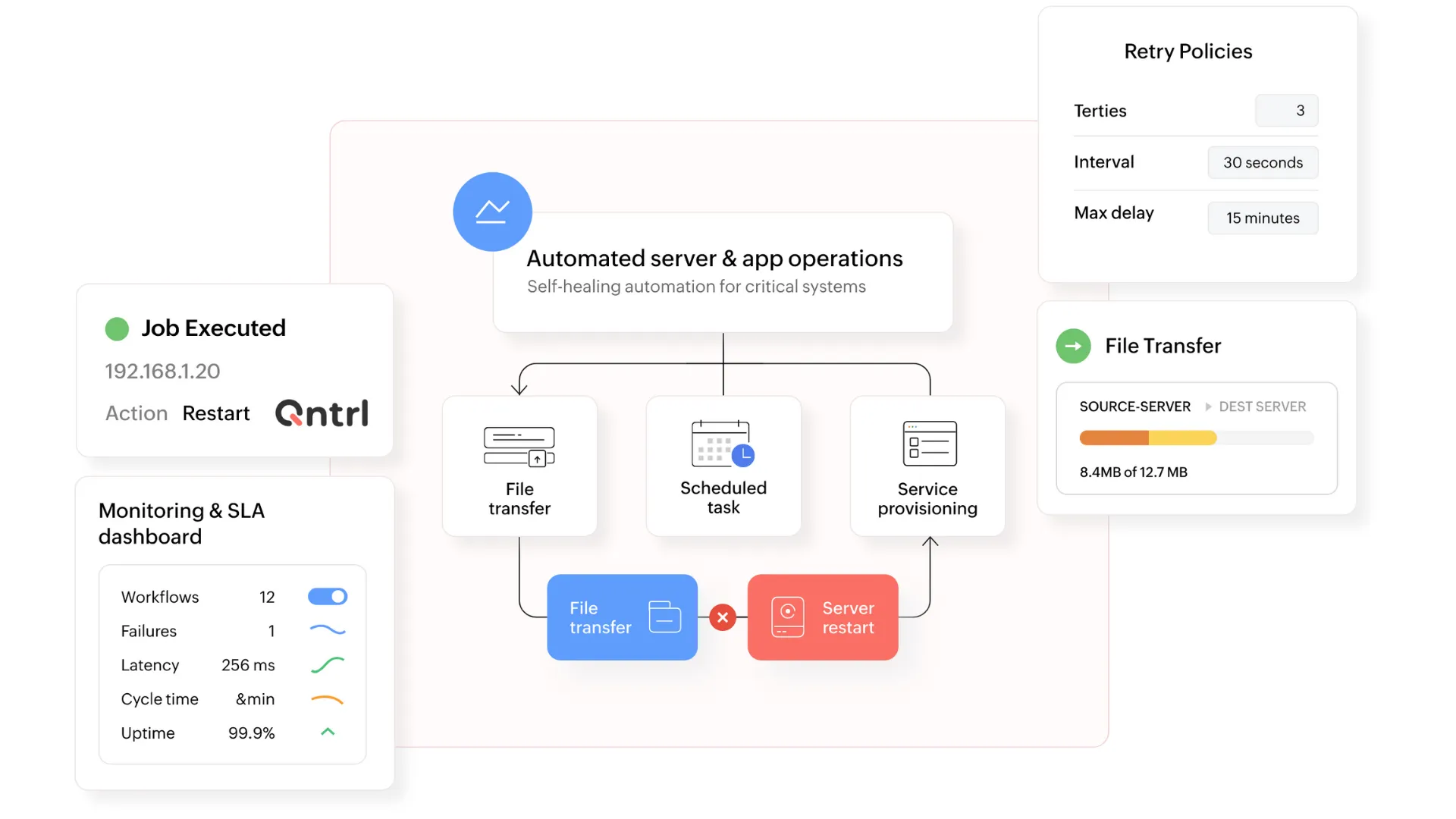
Best for Streamlining Sales Process Transparency
Free plan available
From $8/user/month (billed annually)
Rating: 4.3/5
Qntrl (pronounced control) is Zoho’s specialized workflow orchestration platform built to bring clarity, accountability, and automation to business operations , particularly in sales teams dealing with approval chains, follow-ups, and lead handoffs.
Its strength lies in process visibility: managers can instantly see where every deal or request stands, who’s responsible, and what the next step is. Qntrl is perfect for small-to-mid-sized sales teams that need more structure and transparency without the overhead of complex enterprise systems.
Why I Picked Qntrl
Sales teams often lose valuable time chasing updates or waiting on approvals , whether it’s discount requests, pricing validations, or contract sign-offs. Qntrl’s design directly addresses that bottleneck by turning each sales process into a trackable, rule-based workflow.
It allows sales managers to build visual flowcharts (called “Orchestration Maps”) to define every step in a process, from lead qualification to client onboarding. Rules can be applied to automatically route deals based on value, region, or product line.
It’s also strong in compliance-focused automation , ensuring every sale passes through the right sequence of checks and validations before closing.
Qntrl Standout Features & Integrations
Standout features include:
- Orchestration Builder: A drag-and-drop workflow designer that creates custom sales pipelines and approval flows.
- Conditional Triggers: Automatically initiate tasks, notifications, or document generation based on deal status or field values.
- Audit Trails: Every step is tracked for accountability and performance measurement.
- Role-Based Access: Keeps visibility clean , sales reps only see what’s relevant to them, while managers have a complete overview.
Integrations:
Qntrl integrates smoothly with Zoho CRM, Slack, Microsoft Teams, Google Workspace, and other Zoho applications. It also connects via API and webhook for advanced integrations with third-party systems or custom CRMs.
Pros and Cons
Pros:
- Simple interface with clear workflow mapping
- Ideal for approval-based sales operations
- Affordable and scalable for growing teams
Cons:
- Limited advanced analytics compared to enterprise tools
- Fewer third-party integrations than monday.com or Wrike
Why Qntrl Works for Sales Teams
Sales success depends on speed and clarity. Qntrl ensures both by keeping workflows predictable, accountable, and auditable. Teams always know what’s pending, why it’s delayed, and who’s responsible.
It’s one of the best workflow automation tools for sales teams that prioritize structured approvals and visibility , without the complexity or cost of enterprise software.
5. Miro
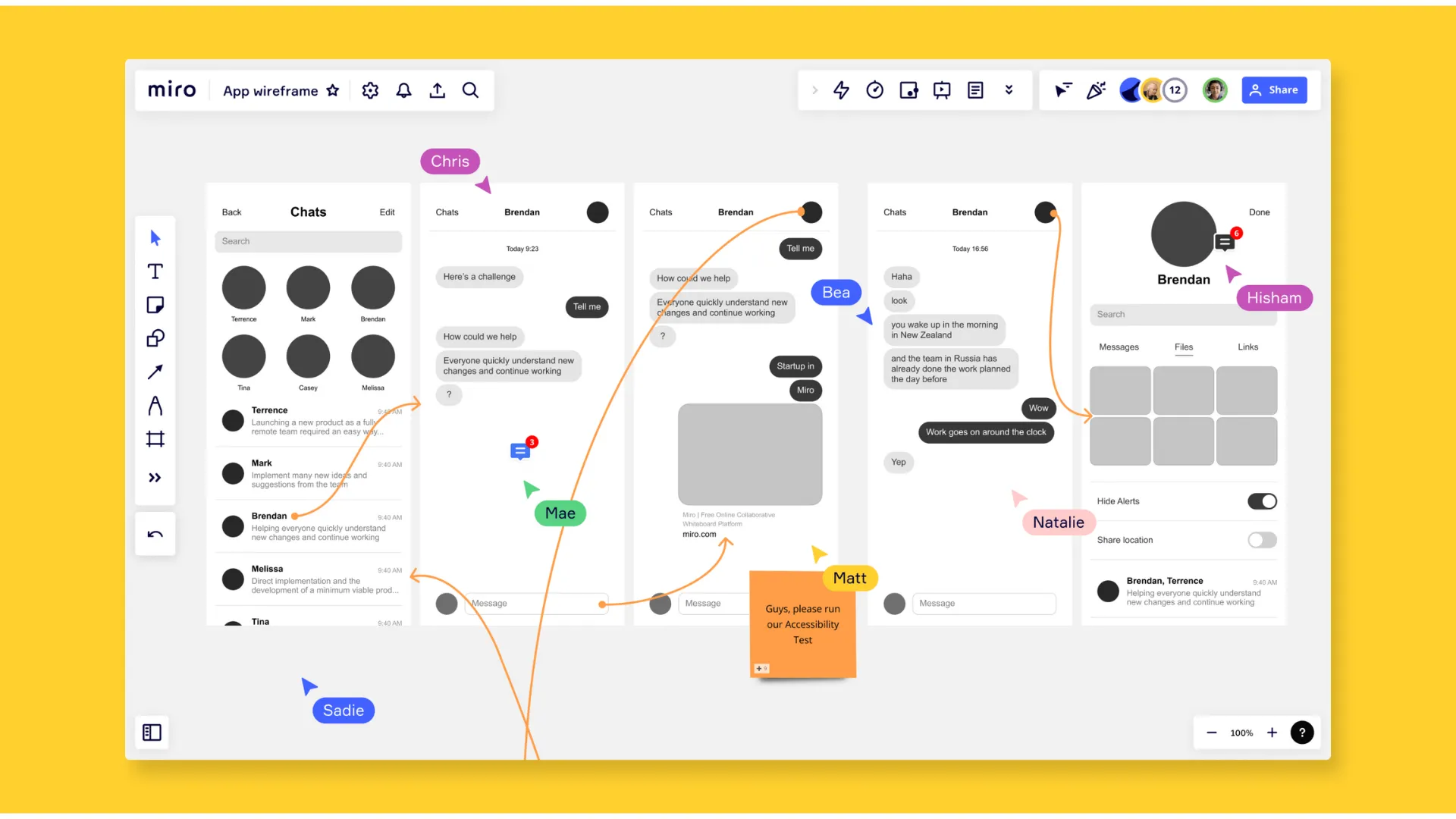
Best for Collaborative Workflow Planning
Free plan available
From $10/user/month (billed annually)
Rating: 4.5/5
Miro is best known as a collaborative whiteboard platform , but its real power for sales automation lies in process visualization and alignment. For teams looking to design and optimize their workflows before automating them, Miro provides a shared visual environment that helps align marketing, sales, and operations around a single process view.
While it doesn’t handle automation execution itself (like Zapier or monday.com), it’s invaluable for mapping, testing, and communicating the logic behind automation sequences , particularly in cross-departmental sales teams.
Why I Picked Miro
Sales leaders often need to design or rethink their workflows before automating them. Miro provides an interactive way to collaborate on that design. Teams can visually lay out the sales process, identify bottlenecks, and use pre-built automation templates to guide system setup later in tools like HubSpot, Salesforce, or Creatio.
It’s especially helpful during workflow discovery and optimization, allowing teams to co-design automation logic that reflects real-world sales processes.
Miro Standout Features & Integrations
Standout features include:
- Sales Workflow Mapping Templates: Templates for pipeline design, CRM automation, and lead nurturing flows.
- Real-Time Collaboration: Ideal for cross-functional sales and marketing meetings.
- Integrations with Automation Platforms: Connects to monday.com, Asana, Jira, and Zapier to translate visual maps into active workflows.
- AI Flowchart Generator: Automatically creates workflow diagrams from text prompts describing your sales process.
Integrations:
Miro integrates with hundreds of business tools including Salesforce, HubSpot, Microsoft Teams, Slack, and Google Workspace.
Pros and Cons
Pros:
- Perfect for visualizing complex workflows
- Encourages collaboration across departments
- AI-powered automation design tools
Cons:
- Doesn’t execute automations directly
- Can be less structured for large-scale automation execution
Why Miro Works for Sales Teams
For any sales organization looking to design, optimize, or standardize its workflows before implementing automation, Miro is invaluable. It bridges the communication gap between sales, operations, and IT , ensuring that everyone builds and understands the same process foundation.
It’s the go-to tool for workflow visualization before committing to automation execution.
6. Nanonets
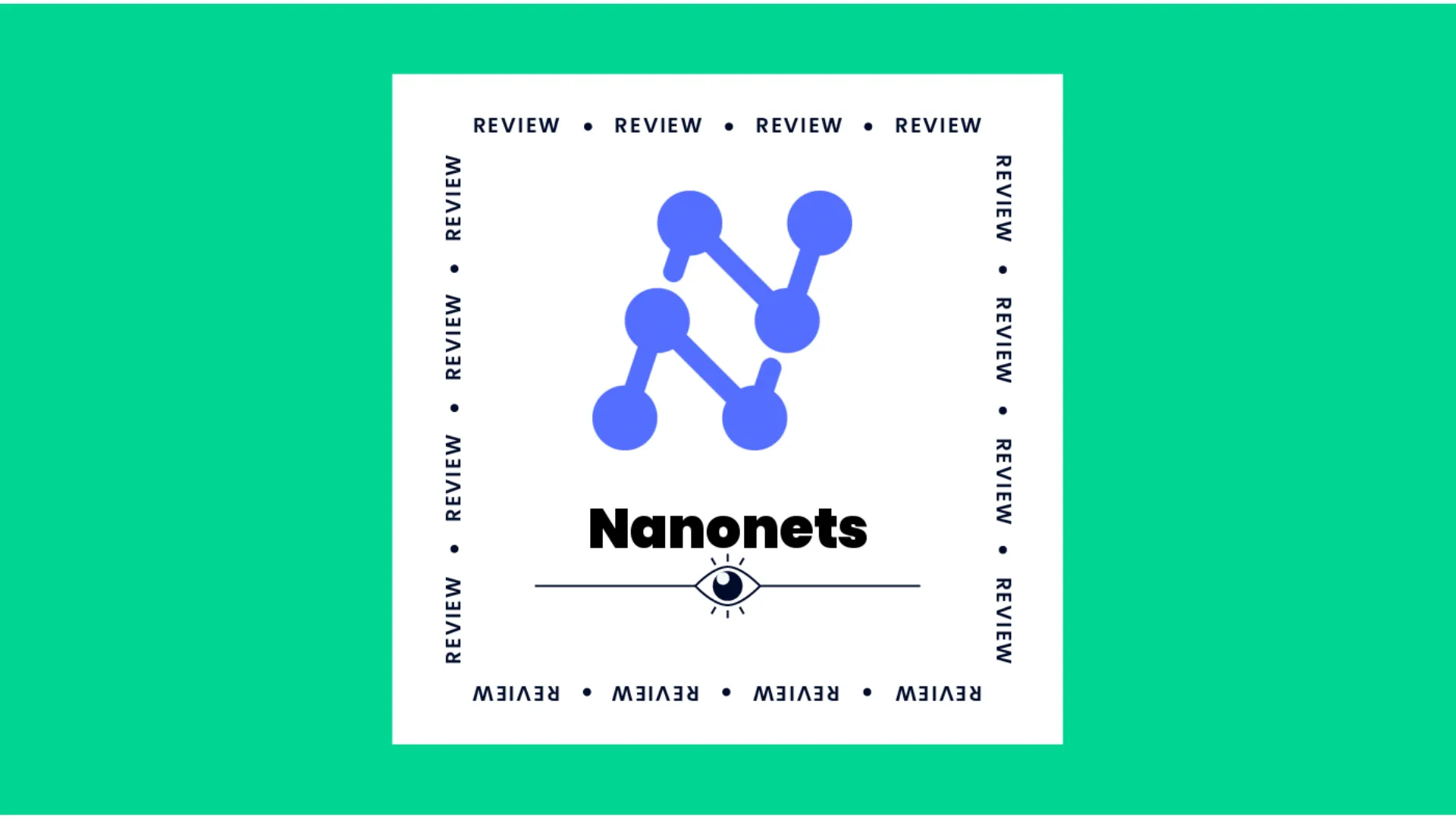
Best for Document and Data Workflow Automation
Free plan available
From $49/month (no user limit)
Rating: 4.4/5
Nanonets focuses on one of the most time-consuming aspects of sales , data and document processing. It uses AI to extract, classify, and route information from unstructured sources like forms, PDFs, invoices, or contracts.
For sales teams dealing with lead forms, order documents, or client verification files, Nanonets can completely automate data entry and workflow initiation , transforming manual paperwork into smooth digital flows.
Why I Picked Nanonets
Most workflow automation tools manage logic and actions, but Nanonets automates data understanding. It reads documents, pulls key fields (like customer name, order value, or company), and triggers workflows based on that extracted information.
For example, when a signed contract arrives in your inbox, Nanonets can automatically extract the deal amount, match it with the CRM record, notify finance, and trigger onboarding.
That ability to bridge the physical and digital makes it an exceptional AI-powered workflow automation platform for sales and operations.
Nanonets Standout Features & Integrations
Standout features include:
- AI-Powered OCR: Extracts data from documents and images with exceptional accuracy.
- Workflow Triggers: Automate follow-ups or CRM updates based on extracted values.
- Custom Models: Train your own AI models to recognize sales-specific documents.
- No-Code Setup: Build automation pipelines without technical expertise.
Integrations:
Nanonets connects with CRMs (Salesforce, HubSpot), Google Drive, Slack, Notion, Airtable, and 5,000+ apps via Zapier or Make (formerly Integromat).
Pros and Cons
Pros:
- Eliminates manual data entry
- Fast setup and accurate AI document processing
- Highly customizable
Cons:
- Focused mainly on document workflows
- Pricing may be high for very small teams
Why Nanonets Works for Sales Teams
Sales teams managing quotes, contracts, or order forms can save countless hours using Nanonets. Its automation ensures critical data flows into the CRM immediately, reducing errors and speeding up deal processing.
It’s particularly valuable for outbound businesses with a high document load , making it one of the best workflow automation tools for sales operations involving paperwork or compliance-heavy sales.
7. Jotform Workflows
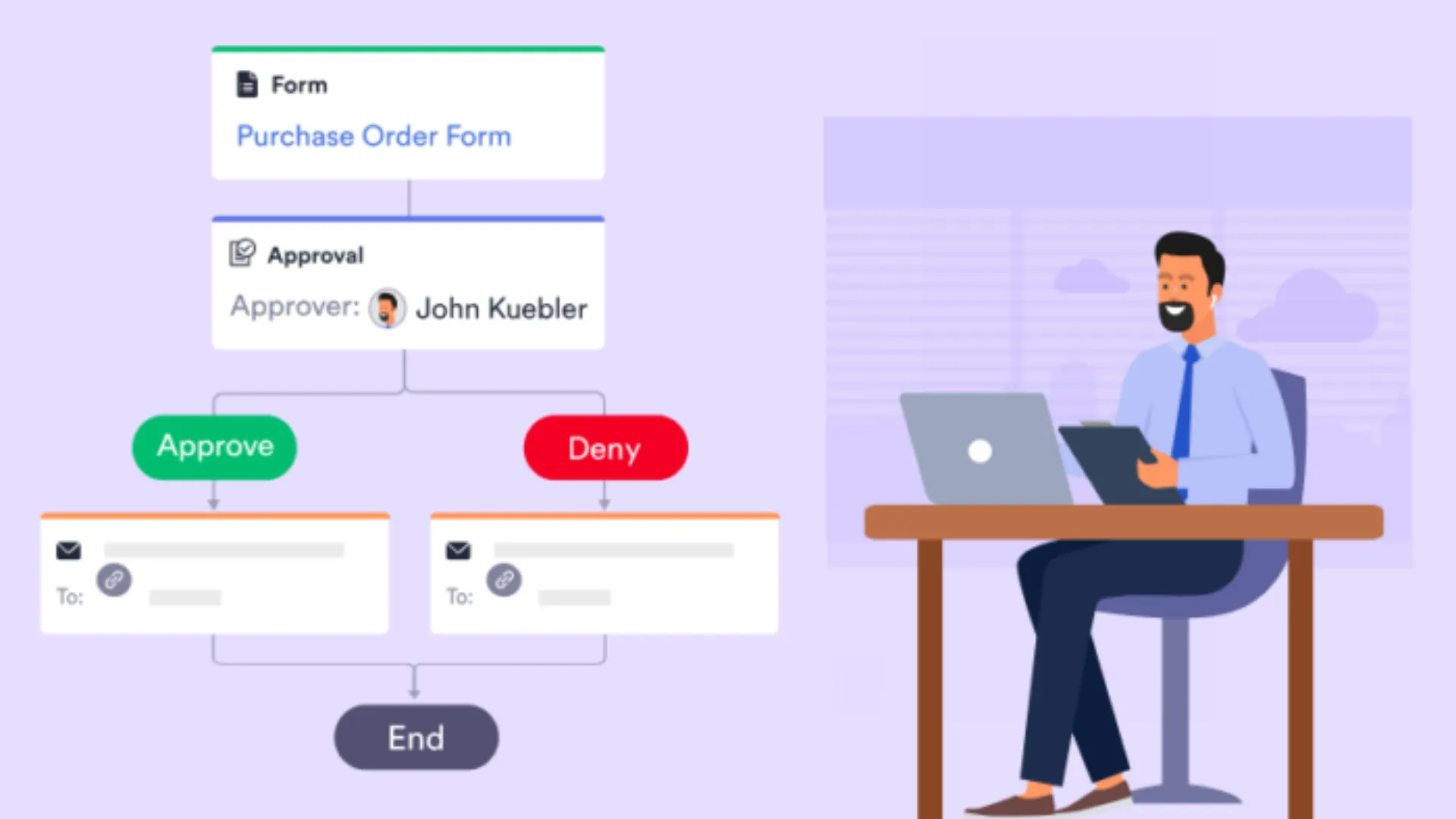
Best for Form-Based Sales Processes
Free plan available
From $34/month
Rating: 4.5/5
Jotform Workflows transforms the familiar online form experience into a powerful automation engine. For sales teams that rely on lead capture, client requests, or proposal submissions, it automates the downstream workflow triggered by those forms.
From routing leads to sales reps, to sending automated follow-ups, Jotform Workflows helps connect your front-end data collection directly to backend automation.
Why I Picked Jotform Workflows
Many sales teams already use web forms to collect leads , but most stop at data capture. Jotform Workflows takes it a step further by automatically initiating sales actions once the form is submitted.
For example:
- A client inquiry form triggers deal creation in your CRM.
- A quote request routes directly to the right sales rep.
- A signed approval form automatically notifies finance and generates an invoice.
It’s a perfect solution for small-to-midsize outbound businesses seeking a simple, no-code way to connect front-end interactions to back-end automation.
Jotform Workflows Standout Features & Integrations
Standout features include:
- Conditional Logic: Different form inputs trigger distinct workflows.
- Approval Flows: Route submissions through internal approvals automatically.
- E-Signature Integration: Streamlines contract signing.
- PDF Automation: Generates documents from submitted data automatically.
Integrations:
Native integrations include Salesforce, HubSpot, Slack, Zoom, Trello, Google Sheets, and Mailchimp. Zapier extends its reach to over 5,000 other applications.
Pros and Cons
Pros:
- Simple, intuitive interface
- Fastest way to automate lead capture workflows
- Excellent for non-technical teams
Cons:
- Limited analytics and reporting
- Less suitable for complex multi-stage automations
Why Jotform Workflows Works for Sales Teams
If your business depends on form-based customer interaction , inbound leads, demo requests, proposal submissions , Jotform Workflows gives you a direct path from form to follow-up. It closes the gap between lead generation and engagement, ensuring faster responses and fewer manual tasks.
8. Studio Creatio
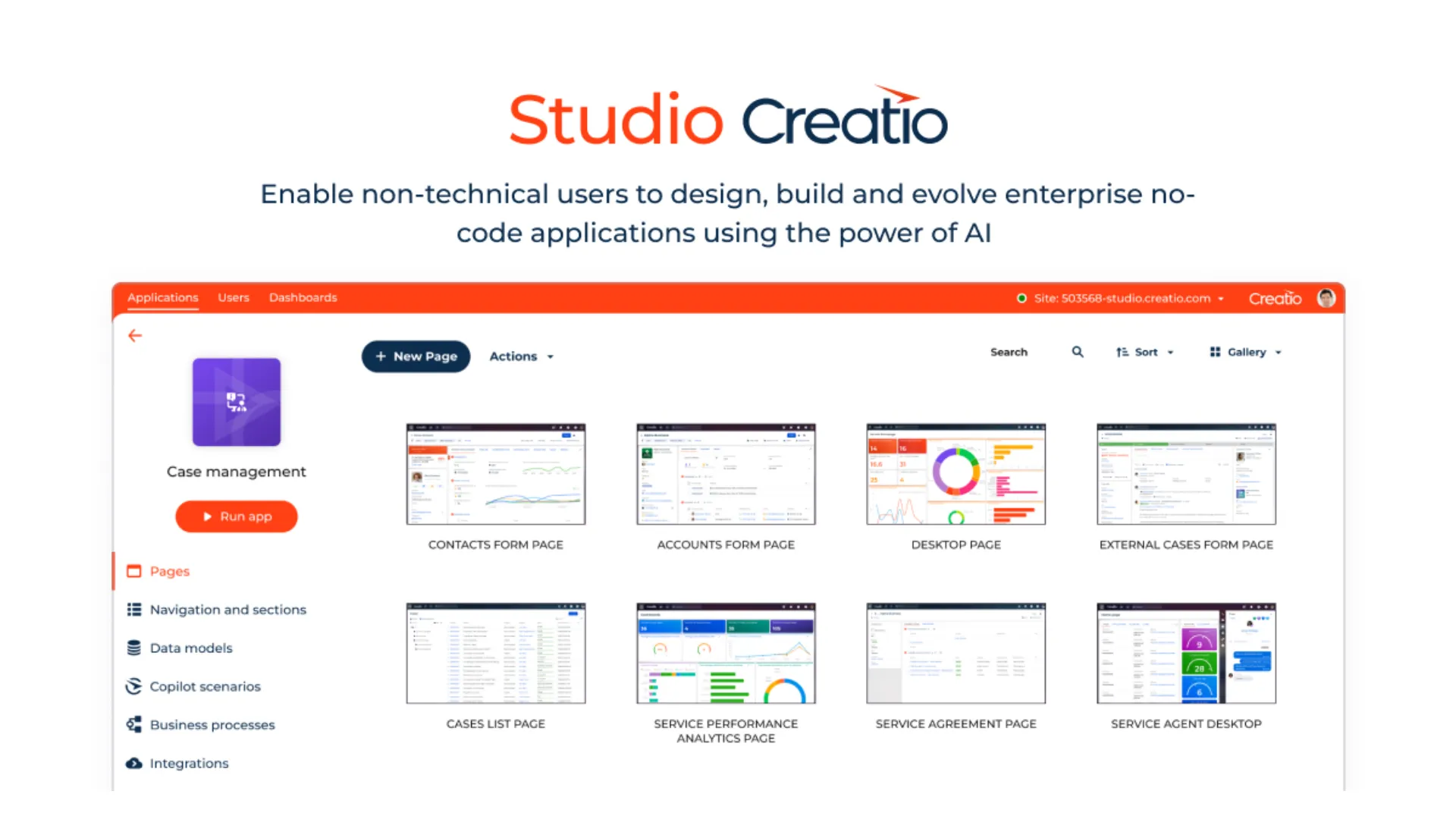
Best for CRM-Driven Workflow Automation
Free trial available
From $25/user/month
Rating: 4.7/5
Studio Creatio is one of the most advanced CRM workflow automation platforms available today. It allows sales organizations to design, execute, and optimize complex workflows that align perfectly with CRM logic , from lead qualification to contract closure.
The platform’s low-code builder enables teams to create customized automation with drag-and-drop simplicity while leveraging CRM data at every stage.
Why I Picked Studio Creatio
What sets Studio Creatio apart is its deep integration between CRM data and process logic. Most workflow tools operate independently from CRM systems, but Creatio builds automation directly into customer data operations.
For example, you can automate actions like “If a lead’s engagement score exceeds 80 and no activity is logged in 3 days, send a follow-up email and assign it to a senior rep.”
Its low-code process designer also allows operations managers to implement sophisticated business rules without coding , making it ideal for outbound and enterprise-level sales environments.
Studio Creatio Standout Features & Integrations
Standout features include:
- Business Process Designer: Low-code interface for visual workflow creation.
- Event-Driven Automations: Triggered by CRM events like status changes or inactivity.
- Performance Dashboards: Real-time monitoring of automation outcomes.
- AI-Driven Optimization: Recommends improvements based on conversion performance.
Integrations:
Creatio integrates natively with Microsoft Outlook, Slack, Zapier, Google Workspace, and major CRMs. Its open API supports custom integrations for enterprise ecosystems.
Pros and Cons
Pros:
- Native CRM-driven workflow engine
- Highly scalable for enterprise sales teams
- Advanced analytics and optimization
Cons:
- Requires onboarding time to master
- Overkill for very small businesses
Why Studio Creatio Works for Sales Teams
For teams that live inside their CRM, Studio Creatio is a powerhouse. It connects every customer touchpoint to automated actions, ensuring faster follow-ups, cleaner data, and higher conversion efficiency.
It’s easily one of the best crm workflow automation tools for 2025 , purpose-built for outbound and data-driven sales organizations.
9. Camunda Platform
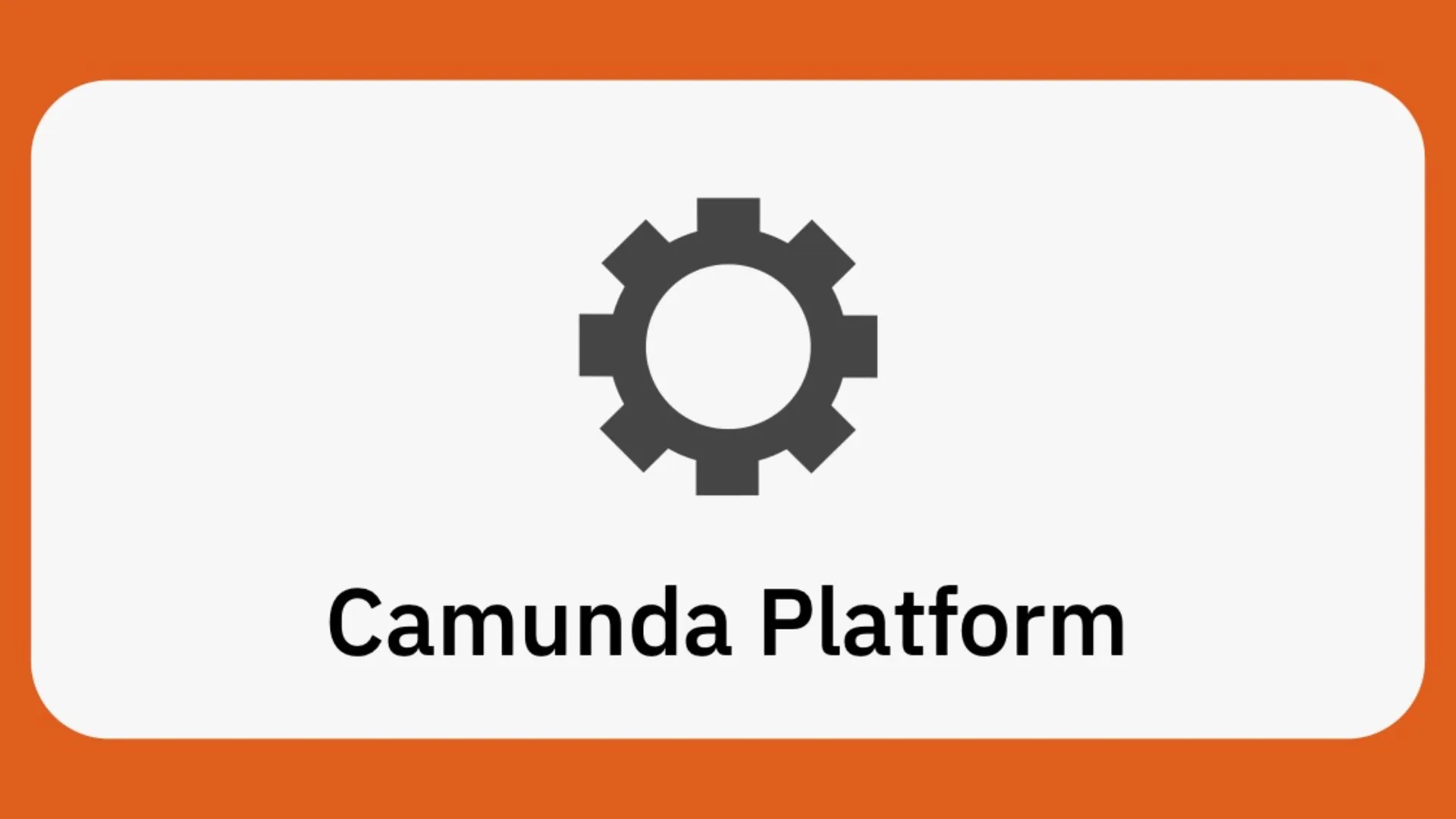
Best for Enterprise-Grade Process Orchestration
Open-source + enterprise options
Custom pricing
Rating: 4.4/5
Camunda is a workflow automation and process orchestration platform built for large enterprises with complex multi-system workflows. It connects CRMs, ERPs, data platforms, and communication tools into unified, automated processes.
Unlike plug-and-play automation tools, Camunda is built for engineering-led organizations that require deep process customization, scalability, and system-wide orchestration.
Why I Picked Camunda
Sales operations in large enterprises often touch multiple systems , from lead management to fulfillment to invoicing. Camunda handles such complex flows by orchestrating multiple automation systems under one framework.
It’s ideal for organizations needing governance, transparency, and customization at scale , especially when handling thousands of concurrent deals or regional sales processes.
Camunda Standout Features & Integrations
Standout features include:
- BPMN 2.0 Process Modeling: Standardized process modeling framework.
- Decision Model Automation: Automates complex decision logic.
- Scalable Engine: Supports millions of process executions daily.
- Open Architecture: Integrates with APIs, CRMs, and databases.
Integrations:
Camunda integrates with Salesforce, SAP, Oracle, Microsoft Dynamics, and any system via REST API or Kafka event streams.
Pros and Cons
Pros:
- Extremely powerful for complex enterprise workflows
- Standards-based process modeling
- Open-source flexibility
Cons:
- Requires technical setup
- Not suited for small or non-technical teams
Why Camunda Works for Sales Teams
Camunda’s strength lies in orchestration , connecting every stage of enterprise sales from lead capture to billing and customer success. It ensures every system and department works in sync, making it ideal for large-scale, high-volume B2B sales operations.


.jpeg)




